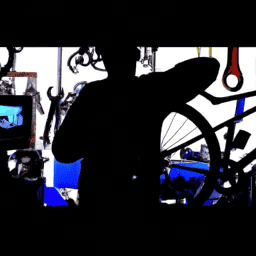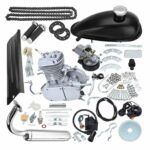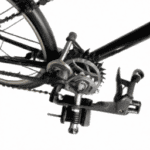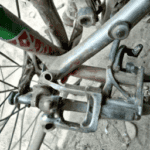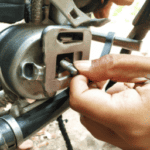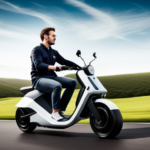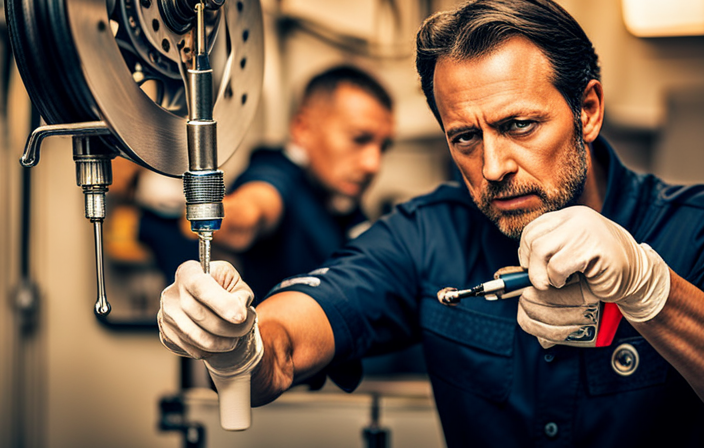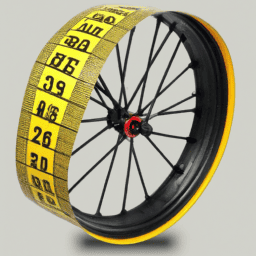Mounting an engine to a bike can be an enjoyable and fulfilling endeavor for those who enjoy working with machinery. If you’re interested in cutting down on fuel costs or simply desire to enhance the power of your bicycle, converting it into a motorized version can prove to be a wise choice. Yet, prior to diving into this project, it’s essential to be aware of several crucial details.
First of all, you’ll need to gather the necessary tools and choose the right engine for your bicycle. There are many different types of engines available, each with its own pros and cons.
You’ll also need to prepare your bicycle for the installation process, including making sure all the necessary parts are in place and the frame is strong enough to support the added weight. Once you have everything you need, it’s time to get started!
Key Takeaways
- Choosing the right engine is important, considering factors like performance, cost, and compatibility with the bike frame.
- Safety precautions should be taken during installation, and proper adjustments and maintenance are crucial for optimal performance and avoiding engine issues.
- Tools needed for installation include wrenches, screwdrivers, pliers, and a drill.
- Adjustment techniques for engine-powered bikes include carburetor adjustments, spark plug gap adjustments, throttle cable tension adjustments, and air/fuel mixture screw adjustments.
Gather the Necessary Tools
You’re going to need some tools if you want to turn your regular old bike into a powerful machine that will make you feel like a superhero!
First and foremost, you’ll need a set of wrenches, including an adjustable wrench, a socket wrench set, and a torque wrench to tighten everything down to the right specifications. You’ll also need a screwdriver set, pliers, wire cutters, and a wire stripper. A set of Allen wrenches is a must-have, as many of the bolts on the engine will require them. Lastly, a set of safety glasses and work gloves are essential to keep you safe from any flying debris or sharp edges.
But before you dive in, it’s important to take some safety precautions. Make sure you’re working in a well-lit area with adequate ventilation so that you don’t inhale any harmful fumes. Also, be sure to wear closed-toe shoes to protect your feet from any dropped tools or parts. Additionally, be mindful of where you’re placing your tools and parts, so you don’t accidentally trip or step on something.
With all the necessary tools and safety precautions in place, you’re ready to move on to the next step: choosing the right engine for your bike.
Choose the Right Engine
When it comes to choosing the right engine for your bicycle, there are a variety of options available. Each type of engine comes with its own set of advantages and disadvantages. From gas-powered to electric, it’s important to consider factors such as power output, fuel efficiency, and ease of installation to select the best engine for your needs.
By taking the time to research and weigh your options, you can ensure that you choose the right engine to meet your specific needs and preferences.
Types of engines available
There are various types of engines that you can install on your bicycle, each with its own unique set of advantages and disadvantages. The two most common types of engines are electric and gasoline engines.
Electric engines are becoming increasingly popular due to their efficiency and low maintenance requirements. They’re also environmentally friendly since they don’t emit harmful gases into the atmosphere. Electric engines are relatively quiet, which makes them ideal for use in urban areas where noise pollution can be a concern. However, electric engines have a limited range and require periodic recharging, which can be inconvenient at times. They’re also more expensive than gasoline engines.
Gasoline engines, on the other hand, are more powerful and have a longer range compared to electric engines. They’re also more affordable and readily available. Gasoline engines require regular maintenance and emit harmful gases into the atmosphere. They’re also noisy, which can be a nuisance in urban areas. Despite their disadvantages, gasoline engines are still widely used due to their reliability and affordability.
When choosing an engine for your bicycle, it’s important to consider factors such as cost, reliability, and performance.
Factors to consider when selecting an engine
If you want to make the most out of your ride, it’s crucial to consider several factors when selecting an engine for your bicycle. The first factor to consider is the performance vs. cost trade-off. High-performance engines tend to be more expensive, but they can provide more power, speed, and acceleration. On the other hand, low-cost engines may have lower performance, but they can be a good option for those who are on a budget.
The second factor to consider is the compatibility with your bicycle frame. Before choosing an engine, you need to make sure that it can fit your bike’s frame. Different engines have different sizes and shapes, so you need to measure your bike’s frame and compare it with the engine’s specifications. You should also consider the weight of the engine, as it can affect your bike’s balance and stability. By taking these factors into account, you can find the right engine that suits your needs and preferences. Now, let’s move on to the next section and prepare your bicycle for the engine installation.
Prepare Your Bicycle
Before you start installing an engine on your bicycle, it’s important to prepare the bike by removing any unnecessary parts and ensuring it’s clean and in good condition.
Firstly, you should remove the pedals and the chain from the bike. This will make it easier to work on the bike and ensure that the engine can be installed properly.
Secondly, you should clean the bike thoroughly using appropriate cleaning techniques to remove any dirt or debris that may affect the installation process.
Lastly, make sure to inspect the bike’s tires, brakes, and other components to ensure they’re in good condition and safe to use.
Safety measures should also be taken into account when preparing the bike for engine installation. Always wear protective gear such as gloves and safety glasses when working with the bike to prevent injuries.
Additionally, make sure to work in a well-lit and well-ventilated area to avoid accidents and inhaling harmful fumes.
Once the bike is prepared, you can move on to the next step of the installation process and install the engine.
Install the Engine
Once you’ve got your ride stripped down and sparkling like a diamond, it’s time to breathe new life into your two-wheeled companion by equipping it with a powerful motor. Installing an engine on a bicycle may seem like a daunting task, but with the right tools and some patience, it can be a rewarding experience. Here are some engine installation tips to help you get started.
First, make sure to read the instructions carefully and follow them step by step. It’s important to take your time and not rush the process. Assemble the engine components according to the manufacturer’s specifications, and mount the engine onto the bike frame securely. Use the 2 column and 5 row table below to see a list of some of the key components you will need to install the engine on your bicycle. If you encounter any problems during the installation process, don’t panic. Use troubleshooting techniques such as checking for loose bolts, making sure the wiring is properly connected, and ensuring that the fuel and oil levels are correct.
| COMPONENTS | TOOLS REQUIRED |
|---|---|
| Engine | Wrench |
| Carburetor | Screwdriver |
| Exhaust | Pliers |
| Clutch | Allen key |
| Chain | Chain breaker |
With the engine securely mounted, it’s time to move on to the next step: testing and adjusting. This will ensure that your bike is running smoothly and safely.
Test and Adjust
Now that I’ve installed the engine on my bicycle, it’s crucial to test it before hitting the road. I’ll start the engine and let it run for a few minutes to check for any leaks, strange noises, or vibrations.
If any issues arise, I’ll make the necessary adjustments for optimal performance. This could include tightening bolts or adjusting the carburetor.
Test the engine after installation
To ensure proper installation, you’ll want to test the engine after it’s mounted onto the bicycle frame.
The first thing to check is the fuel efficiency. Start the engine and let it idle. Observe the amount of fuel consumed and compare it to the manufacturer’s specifications. If there’s a significant difference, you may need to troubleshoot common problems such as a clogged air filter or a misadjusted carburetor.
Another thing to check is the engine’s performance. Take the bicycle for a test ride and observe how the engine performs under different conditions such as uphill climbs or downhill descents. Pay attention to any unusual noises or vibrations. If you notice anything out of the ordinary, investigate the cause and make the necessary adjustments for optimal performance.
With these tests passed, you can be confident that the engine is properly installed and ready for use.
Make necessary adjustments for optimal performance
Achieving optimal performance requires adjustments that you’ll need to make carefully and thoughtfully. Once you’ve installed the engine on your bicycle, you’ll need to fine-tune it to ensure that it runs smoothly and efficiently.
Adjustment techniques can include adjusting the carburetor, adjusting the spark plug gap, and adjusting the throttle cable tension. To adjust the carburetor, start by turning the idle speed screw until the engine idles smoothly. Next, adjust the air/fuel mixture screw until the engine runs smoothly at idle and acceleration. If the engine runs rough or stalls, you may need to adjust the spark plug gap or clean the air filter.
Regular maintenance tips include changing the oil and oil filter every 500 miles, checking the tire pressure, and inspecting the brakes and chain for wear. With the right adjustments and maintenance, you can enjoy a smooth ride and optimal performance from your engine-powered bicycle.
Frequently Asked Questions
What is the maximum weight limit for an engine to be installed on a bicycle?
Like a sturdy oak bending under the weight of a storm, a bicycle can only bear so much. Weight limitations and engine power requirements are crucial factors to consider before installing an engine on a bicycle.
Can any type of bicycle be used for engine installation or are there specific requirements?
When considering engine installation on a bicycle, compatibility is essential. The bicycle must be sturdy with a strong frame and reliable brakes. The engine size should also be appropriate to avoid overburdening the bicycle’s structure.
How long does the installation process usually take?
Installing an engine on a bicycle can take anywhere from a few hours to a few days, depending on factors such as experience level, type of engine, and bike frame. Common mistakes to avoid include improper wiring and inadequate engine mounting.
Do I need any special permits or licenses to ride a motorized bicycle?
Licensing requirements for motorized bicycles vary by state, but most require a driver’s license or permit and registration. Road safety considerations include wearing a helmet, obeying traffic laws, and ensuring the bike is properly maintained.
Is it possible to remove the engine and convert the bicycle back to its original state?
Removing the engine and reverting the bicycle to its original state is possible, but it involves a few challenges. Pros include weight reduction and cost savings, while cons include decreased speed and range. Maintenance tips involve checking the brakes and chain regularly.
Conclusion
Well, folks, that’s how you install an engine on a bicycle. It may seem daunting at first, but with the right tools, engine, and preparation, it’s a breeze.
Just like a painter needs a brush and canvas, a cyclist needs an engine and a bicycle to create their masterpiece on the road.
Now, I know some of you might be thinking, ‘Why bother with an engine? Can’t I just ride a regular bicycle?’ Sure, you can. But why settle for ordinary when you can have extraordinary?
With an engine, you can go faster, farther, and conquer hills with ease. It’s like having a secret weapon that gives you a competitive edge.
So, go ahead and unleash your inner speed demon and take your cycling game to the next level with an engine.
